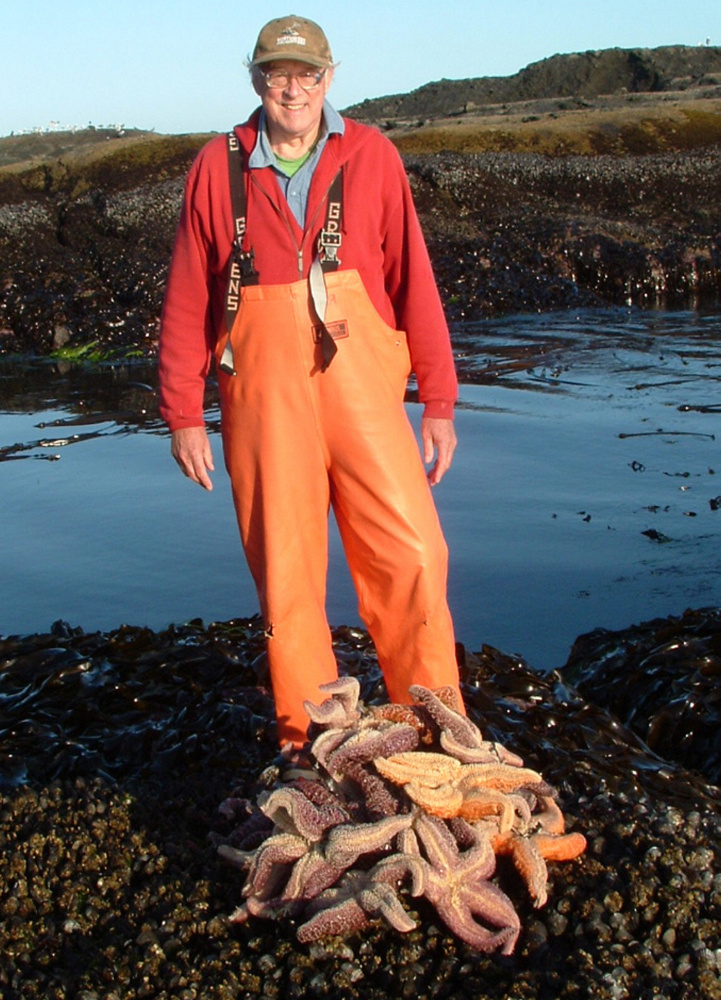Robert “Bob” Paine, an ecologist who conducted seminal experiments along the coast of Washington state in the 1960s, pulling starfish from the rocks and tossing them back into the ocean to demonstrate the consequences of disrupting an ecosystem with the removal of a single “keystone” species, died Monday at a hospital in Seattle. He was 83.
The cause was acute myeloid leukemia, according to Jennifer Ruesink, a biology professor at the University of Washington, where Paine trained younger ecologists from 1962 until, and well beyond, his official retirement in 1998.
Paine was regarded as one of the most significant ecologists of his era, a scientific adventurer who trekked across wave-battered shores of the Pacific Northwest to observe, document and explain the forces that govern and sometimes upset the complex network of creatures in an ecosystem.
His concept of “keystone” species, named after the stone at the apex of an arch that supports the other blocks in the structure, refers most strictly to predators such as sea otters, wolves and lions with outsize influence on their communities. A groundbreaking idea when Dr. Paine introduced it in the late 1960s, the “keystone” species is today a fundamental of ecology textbooks.
He was a naturalist “in the tradition of Charles Darwin,” Simon Levin, a Princeton University ecologist and recipient of the National Medal of Science, said in an interview.
Paine’s fieldwork in Washington – first in Makah Bay, on the outer reaches of the Olympic Peninsula, and later on the nearby uninhabited Tatoosh Island – was “one of the most famous experiments in all of ecology,” Levin said.
In a defined swath of rock, Paine manually removed each starfish of the species Pisaster ochraceus and tossed it to sea. He repeated the process several times a year, clearing the rock of all ochre sea stars, as the animals are commonly known.
The result was astonishing: In short order, the rock scarcely resembled its former self. The population of mussels, on which the starfish feed, skyrocketed. Mussels took over the rock, eventually crowding out other species that competed for space, including barnacles, the aquatic snails known as limpets and chitons, a type of marine mollusk. Anemones and sponges also became less populous.
In all, seven of 15 original species disappeared, according to an account in the publication Nautilus. By a description in the journal Nature, “a diverse tidal wonderland became a black monoculture of mussels.”
Paine published his findings of the event, which he called a “trophic cascade,” in a now-classic article in the journal the American Naturalist, “Food Web Complexity and Species Diversity” (1966). Three years later, he introduced “keystone” species as an ecological term.
“These individual populations are the keystone of the community’s structure,” he observed, “and the integrity of the community and its unaltered persistence through time, that is, stability, are determined by their activities and abundances.”
Along with competition between species, the notion of keystone predators helped shape modern understanding of ecology and was later revised to describe any species, not necessarily a predator, with disproportionate influence on its environment.
“Its importance,” Paine explained, “is that it convinced managers and conservationists alike that the ecological impact of single species matters.”
Besides the impact of his findings, Paine’s work was notable, Levin said, because “nobody had done this level of experimental manipulation of a natural system.” Paine was credited with helping push ecology from natural observation to experimentation such as could be found in a laboratory.
Paine spent years conducting research on Tatoosh Island, a small piece of land off Cape Flattery, the northwesternmost point of the continental United States. It belonged to the Makah Indian tribe and was home of a universe of creatures, including dozens of species of algae, peregrine falcons, eagles, puffins and sea lions.
To conduct his work, Paine received financial support from the National Science Foundation and permission from the tribe, whose only request was that he not “mess with the graves,” the Seattle Times reported.
“Working on a remote island was not easy,” Ruesink, who conducted research with Paine on Tatoosh Island, wrote in a tribute to him, recalling the “leaps of faith across surge channels, slippery algae that could take down the most sure-footed, boats overturned and scientists bodily moved by rogue waves, all supplies hefted from the beach to the top of the island via a hundred home-made steps.”
“As each tide rose and chased ecologists from their intertidal studies,” she wrote, “Bob doled out a measure of box wine into a mug and sat down with his current scientific family to talk about what each had seen and learned.”
Robert Treat Paine was born April 13, 1933, in Cambridge, Massachusetts.
“All my early childhood memories involve biology,” he told an interviewer with the University of Washington. “I remember sitting in the dirt driveway when I was around two-and-a-half years old and watching ants – I was utterly fascinated with nature from a very young age.”
He received a bachelor’s degree from Harvard University in 1954. At the University of Michigan, he began his graduate career studying fossils but was lured into the study of living animals by an inspiring class on freshwater invertebrates. He received a master’s degree in 1959 and a PhD in zoology in 1961.
A complete list of survivors could not be confirmed.
Paine received honors that included induction into the National Academy of Sciences. His research took him to habitats around the world, from Mexico to New Zealand. But he was best known for his work on Tatoosh Island, whose riches have been compared to those of the Galápagos Islands, where Darwin made his laboratory in the 19th century.
“I never tire of it,” Paine told the Seattle Times. “It’s always changing.”
Send questions/comments to the editors.


